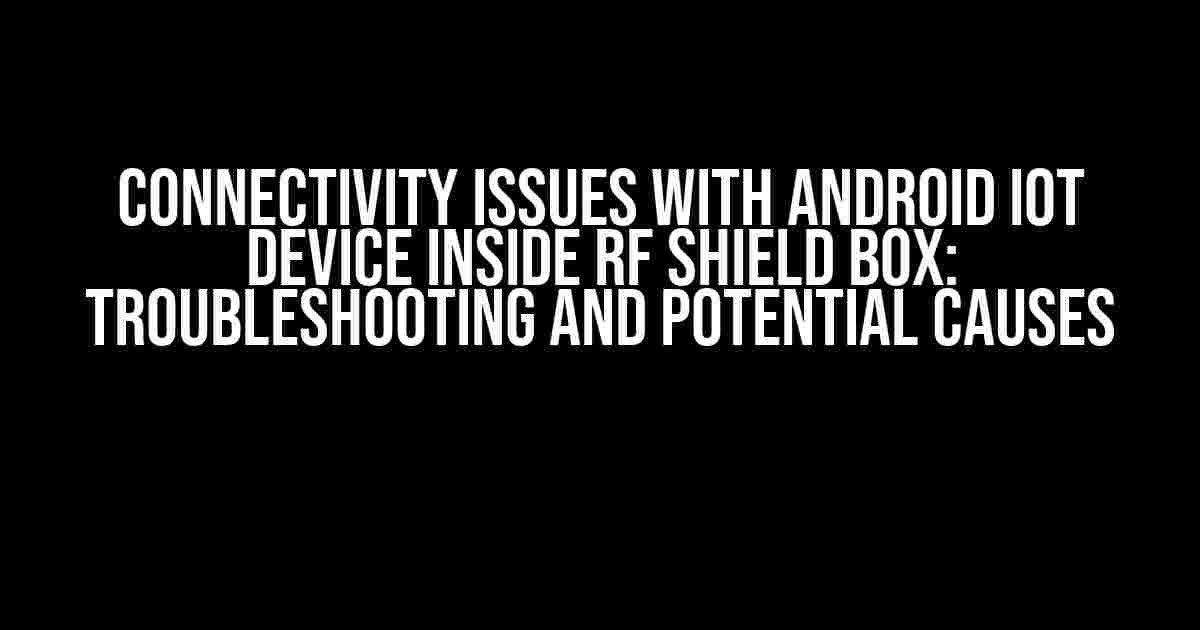When it comes to testing and deploying Android IoT devices, ensuring reliable connectivity is crucial. However, when your device is placed inside an RF shield box, things can get complex. In this article, we’ll delve into the common connectivity issues that arise when an Android IoT device is placed inside an RF shield box, and provide you with a comprehensive troubleshooting guide to help you identify and resolve the problems.
The Importance of RF Shield Boxes in IoT Development
In the world of IoT development, RF shield boxes play a critical role in ensuring the reliability and security of devices. These boxes are designed to block electromagnetic interference (EMI) and radio-frequency interference (RFI), allowing developers to test and validate their devices in a controlled environment. By isolating the device from external electromagnetic signals, RF shield boxes enable developers to:
- Test device performance in a noise-free environment
- Validate device functionality without external interference
- Ensure compliance with regulatory standards for EMI and RFI
Common Connectivity Issues Inside an RF Shield Box
Despite the benefits of RF shield boxes, they can sometimes interfere with device connectivity. Here are some common issues you may encounter:
1. Weak or No Signal
One of the most common issues is a weak or no signal. This can occur due to the RF shield box’s ability to block electromagnetic signals, including Wi-Fi and cellular signals.
2. Intermittent Connectivity
Another issue is intermittent connectivity, where the device connect and disconnects repeatedly. This can be frustrating and difficult to diagnose.
3. Slow Data Transfer Rates
Slow data transfer rates can occur due to the RF shield box’s impact on signal strength and quality.
Troubleshooting Connectivity Issues Inside an RF Shield Box
Now that we’ve covered the common connectivity issues, let’s dive into some troubleshooting steps to help you identify and resolve the problems:
Step 1: Check the RF Shield Box Configuration
Verify that the RF shield box is properly configured for your device’s specific frequency band. Ensure that the box is set to the correct mode (e.g., Wi-Fi, cellular, or Bluetooth) and frequency range.
// Example RF shield box configuration code
// Set frequency range to Wi-Fi (2.4 GHz)
rfshield.configure(frequency_range=WiFi_24GHz)
// Set mode to Wi-Fi
rfshield.set_mode(WiFi_MODE)
Step 2: Check the Device’s Antenna Orientation
Verify that the device’s antenna is properly oriented inside the RF shield box. Ensure that the antenna is not blocked by any obstacles and is positioned to maximize signal strength.
| Antenna Orientation | Signal Strength |
|---|---|
| Optimal orientation (antenna parallel to box wall) | Strong signal |
| Suboptimal orientation (antenna perpendicular to box wall) | Weak signal |
Step 3: Check for Interference from Other Devices
Verify that there are no other devices inside the RF shield box that could be causing interference. Remove any unnecessary devices and repeat the test.
Step 4: Perform a Signal Strength Test
Use a signal strength testing tool to measure the signal strength inside the RF shield box. Compare the results to the device’s specifications to determine if the signal is weak.
// Example signal strength testing code
signal_strength = sig_test.measure_signal_strength()
if signal_strength < -70 dBm:
print("Signal strength is weak")
else:
print("Signal strength is strong")
Step 5: Consult the Device’s Documentation
Refer to the device’s documentation and manufacturer’s guidelines for testing and troubleshooting connectivity issues inside an RF shield box.
Potential Causes of Connectivity Issues Inside an RF Shield Box
Now that we’ve covered the troubleshooting steps, let’s explore some potential causes of connectivity issues inside an RF shield box:
1. RF Shield Box Design and Materials
The design and materials used in the RF shield box can affect signal strength and quality. For example, a box with a thicker metal wall may block signals more effectively, but may also reduce signal strength.
2. Device Antenna Design and Placement
The device’s antenna design and placement can impact signal strength and quality. A poorly designed or placed antenna can struggle to maintain a strong signal inside the RF shield box.
3. Interference from Other Devices
Other devices inside the RF shield box can cause interference, reducing signal strength and quality.
4. Environmental Factors
Environmental factors such as humidity, temperature, and physical obstructions can affect signal strength and quality.
Conclusion
In conclusion, connectivity issues inside an RF shield box can be frustrating, but with the right troubleshooting steps and knowledge of potential causes, you can identify and resolve the problems. By following the steps outlined in this article, you’ll be well on your way to ensuring reliable connectivity for your Android IoT device. Remember to always consult the device’s documentation and manufacturer’s guidelines for specific testing and troubleshooting procedures.
By understanding the importance of RF shield boxes in IoT development and addressing common connectivity issues, you can develop and deploy reliable and secure IoT devices that meet the demands of your application.
Here are 5 Questions and Answers about “Connectivity Issues with Android IoT Device Inside RF Shield Box: Troubleshooting and Potential Causes”
Frequently Asked Question
Get answers to your burning questions about troubleshooting connectivity issues with your Android IoT device inside an RF shield box!
What are the common signs of connectivity issues with my Android IoT device inside an RF shield box?
Common signs of connectivity issues include failed data transmission, sluggish response times, and inconsistent network connections. You may also notice that your device is unable to connect to the internet, send or receive data, or communicate with other devices. If you’re experiencing any of these symptoms, it’s likely that your device is struggling to maintain a stable connection.
How can I troubleshoot connectivity issues with my Android IoT device inside an RF shield box?
To troubleshoot connectivity issues, start by checking the device’s antenna configuration and position within the RF shield box. Ensure that the antenna is properly oriented and not obstructed. Next, verify that the device’s Wi-Fi or cellular settings are correctly configured. You may also want to perform a network reset, update the device’s firmware, or try connecting to a different network. If the issue persists, consider using a network analyzer to detect any interference or signal strength issues.
What are some potential causes of connectivity issues with my Android IoT device inside an RF shield box?
Common causes of connectivity issues include RF interference from other devices, physical obstructions, and poor antenna design or placement. Additionally, firmware or software bugs, insufficient network coverage, and incorrect device configuration can also contribute to connectivity problems. In some cases, the RF shield box itself may be causing signal attenuation or interference.
How can I optimize the antenna design and placement inside the RF shield box to improve connectivity?
To optimize antenna design and placement, consider using a directional antenna that can be oriented to maximize signal strength. Place the antenna in a location with minimal obstruction and ensure it’s not too close to the RF shield box’s walls or other components. You may also want to experiment with different antenna types, such as a patch antenna or a dipole antenna, to find the best fit for your device.
What are some best practices for configuring my Android IoT device’s network settings to minimize connectivity issues?
To minimize connectivity issues, ensure that your device’s network settings are correctly configured. This includes setting the correct Wi-Fi or cellular frequency band, configuring the device’s IP address and subnet mask, and enabling or disabling features like Wi-Fi roaming or cellular fallback. Additionally, consider implementing network redundancy or failover mechanisms to ensure that your device can switch to a backup network in case of an outage.


